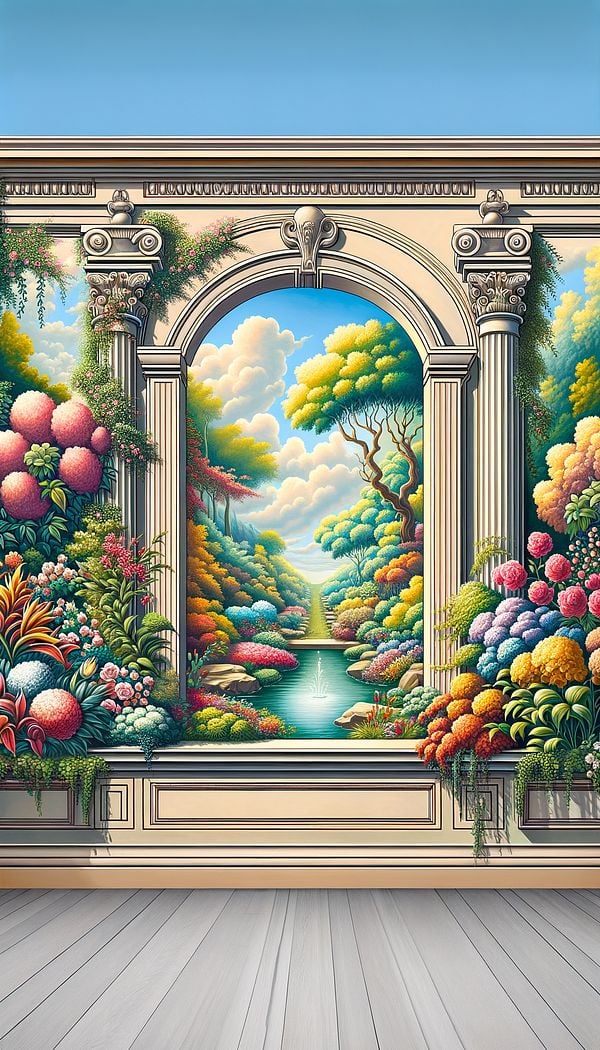What is Trompe L'oeil?
Trompe l'oeil is a decorative painting technique that creates the optical illusion of three-dimensional space on a flat surface.
Description
Trompe l'oeil, French for "deceive the eye," is a fascinating and inventive painting technique that has been used since ancient times to create the illusion of three-dimensional space on a flat surface. This technique relies on the meticulous use of perspective, shadow, and other visual cues to trick the observer's eye into perceiving a painted detail as a real, three-dimensional object. Trompe l'oeil can be applied to various surfaces, including walls, ceilings, and even small objects, adding depth and intrigue to otherwise flat expanses.
The mastery involved in creating a successful trompe l'oeil piece requires a deep understanding of perspective, light, and color. Artists and designers who specialize in this technique must skillfully manipulate these elements to achieve the desired illusion of depth and reality. Trompe l'oeil is often used in interior design to enhance the architectural features of a space, bring light and openness into a room, or introduce an element of surprise and creativity. It's a versatile tool that can be adapted to suit a wide range of design styles, from classical to contemporary.
The use of trompe l'oeil in interior design not only showcases artistic skill but also adds a layer of personalization and uniqueness to a space. By incorporating scenes, landscapes, or fantastical elements, designers can create immersive environments that reflect the interests and personalities of the inhabitants.
Usage
Trompe l'oeil is widely used in interior design to create visually striking features in both residential and commercial spaces. Examples include murals that simulate architectural elements like windows, doors, or columns, landscapes that extend the perceived space of a room, and playful illusions that can make a flat surface appear to have shelves, niches, or hidden doorways.
FAQs
-
Can trompe l'oeil be used outdoors?
Yes, trompe l'oeil can be applied to outdoor surfaces as well, such as exterior walls or garden fences, to create captivating visual illusions in open spaces.
-
Is trompe l'oeil suitable for all interior design styles?
While trompe l'oeil can be adapted to a variety of design styles, its suitability depends on the overall aesthetic vision and desired effect. It works particularly well in spaces where an element of fantasy or artistic flair is desired.
-
How long does a trompe l'oeil mural last?
The longevity of a trompe l'oeil mural depends on factors like the quality of materials used, the surface it's applied to, and exposure to environmental conditions. Indoors, with proper maintenance, a trompe l'oeil painting can last for many years.
Practical Application
When considering incorporating trompe l'oeil into your interior design project, start by identifying the effect or illusion you wish to achieve. Work with a skilled artist or designer who has experience in this technique to ensure the perspective and details are accurately rendered. Remember to consider the scale and lighting of your space, as these elements are critical to the success of a trompe l'oeil piece. Trompe l'oeil is best applied in areas where it can be fully appreciated, such as focal walls, ceilings, or areas where guests are likely to linger.
-
Design Styles478 articles
-
Decorative Techniques322 articles
-
Historical Periods & Movements150 articles
-
Art & Sculpture30 articles
-
Wall Treatments & Finishes157 articles
-
Night StandA small table or cabinet designed to stand beside a bed.
-
MarbleizingMarbleizing is the process of applying paint or glaze to a surface to imitate the intricate patterns and colors of natural marble.
-
OvoloAn ovolo is a convex molding known for its quarter-round profile.
-
MullionA vertical bar between the panes of glass in a window.
-
StrapworkStrapwork refers to a decorative motif featuring interlaced straps or bands.
